Army Plays High-Tech Cat-and-Mouse Game
The U.S. Army may be catching up to adversaries in the information warfare domain, but the pace of change remains a challenge.
“The biggest [capability] gap we have is keeping pace. It is very much a cat-and-mouse game. When you have a cat-and-mouse game, you see a lot of change, so we try to anticipate things,” says Gary Blohm, who directs the Intelligence and Information Warfare Directorate (I2WD) at Aberdeen Proving Ground, Maryland.
In fact, the Army anticipates fighting a future adversary with technological capabilities matching, or nearly matching its own. That requires a major shift on the service’s part after many years of fighting in Iraq and Afghanistan, where the United States held a decisive technological edge. “That doesn’t mean that we’re not still worried about current operations, but we certainly understand the threat of the near-peer, and we’ve shifted our work to that,” Blohm says.
Blohm, the primary subject matter expert for the recent Army Mounts IW Comeback article, outlines three areas of rapid change: the threat, technology itself and the readily availability of advanced systems.
"The pace of change may be most evident in the realm of cybersecurity. "It’s evolving every day, actually. One of the challenges we have is that it’s such a fast moving train,” Blohm adds.
Typically, researchers identify a threat, develop a basic solution, mature that technology some years later and then deliver it to a program manager for further maturation. But that model no longer works, especially in the cyber world. “We used to get a threat, we’d work on it for awhile, we’d fix that threat, and then we’d get another threat and we would work on it for awhile,” Blohm reports. “Now, we cannot wait for that happen. We move very rapidly in the cyber domain from idea or requirement to writing code to testing that code and moving out.”
Furthermore, technological capabilities that were once only available to governments can now be purchased off-the-shelf at the local Walmart, Blohm notes. Drones are an obvious example, but there are others. “There was a time when you had to be in the military to have night vision goggles. It’s amazing what you can buy now. We’re working hard to stay ahead of the game there.”
Blohm says he finds inspiration every day when he walks into the building where he works. McAfee Hall, also known as building 6003, is named after Col. Charles S. McAfee, who earned a doctorate degree in 1949 from Cornell University. In 1956, President Eisenhower presented him with one of the first Secretary of the Army Research and Study Fellowships, which he used for post-doctoral studies in radio astronomy and ionospherics at Harvard University, according to the American Astronomical Society. He helped analyze data collected during high altitude nuclear explosions in 1959-60, which demonstrated for the first time that nuclear explosions cause communication blackouts. He also researched wave propagation, passive sensing, target acquisition and battlefield surveillance, and he taught atomic and nuclear physics and solid-state electronics courses at Monmouth University.
Blohm recalls McAfee’s work on Project Diana, which BlackPast.org describes as a scientific collaboration in which engineers “studied the Earth’s relationship to the moon via radar signal echoing.” McAfee’s calculations played a major role in the 1946 experiment that bounced the first radar signals off the moon. “He was really an innovator in radar, and to me, that sets the stage for what we have to continue to do,” Blohm says.





Comments